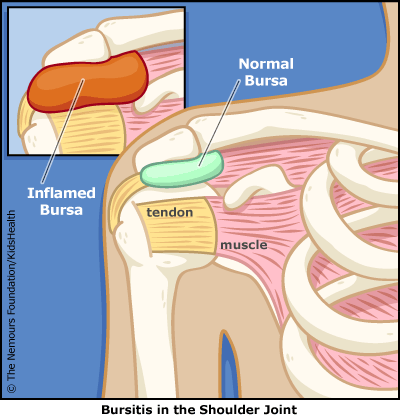What Is Bursitis?
Bursitis is swelling and irritation of a bursa. A bursa is a saclike structure that cushions joints. Bursitis (ber-SYE-tiss) usually happens in a shoulder, elbow, hip, or knee. But it can happen in other joints too.
What Are the Signs & Symptoms of Bursitis?
Signs and symptoms of bursitis can include:
- joint pain
- joint stiffness
- joint swelling
- redness around the area of the joint
Symptoms can vary depending on which joint is involved, what caused the irritation, and how long the person has had bursitis.
What Causes Bursitis?
Bursitis can happen from:
- overuse (doing the same motion over and over again, such as pitching)
- injury
- arthritis (for example, from rheumatoid arthritis)
- infection
In teens, the most common cause of bursitis is overuse.

How Is Bursitis Diagnosed?
Doctors diagnose bursitis by:
- asking questions about symptoms and activities
- doing an exam
If doctors need more information or to check other injuries, they also might:
- get an ultrasound, MRI, or X-ray
- use a needle to take out some fluid from the bursa and send it for testing
How Is Bursitis Treated?
Treatment depends on the cause. For bursitis caused by overuse, treatment includes:
- rest
- pain relief with ibuprofen (Advil, Motrin, or store brand) or naproxen (Naprosyn, Aleve, or store brand)
- protecting the area with pads (for example, knee pads for kneeling or a cushion for sitting on a chair)
- avoiding positions and activities that press on the area (for example, cutting a slit in the heel of shoes to prevent pressure on the heel)
- applying ice wrapped in a towel or a heating pad for about 15 minutes a few times a day (whichever gives more comfort)
- exercises, stretches, or physical therapy (PT)
- injection of medicine into the bursa
Can Bursitis Be Prevented?
To lower the risk of bursitis:
- Play different sports to prevent doing the same motions all year.
- Use knee pads or a seat cushion when kneeling or sitting for a long time.
- Use proper technique for sports.
- Always warm up and stretch before and after sports.
- Stop activities that cause pain and get checked by a doctor or trainer before going back to the activity.
Medically reviewed by: Alvin Wei-i Su, MDThis link opens in a new tab
Date reviewed: July 2019
